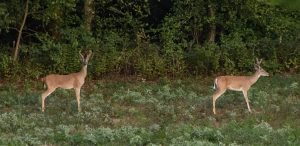Young Bucks and a Fine Goatweed Crop
Even though until recently it has rarely rained here at No Name Farm — and in nearly all of Texas — for months — the goatweed continues to grow. It sprouted everywhere the land was mulched last fall. Goatweed likes loose, sandy soil of which we have an abundance as a result of the mulching, building a pond and spreading the soil out from the pond to create a nice drainage system when it does actually start raining again. Conditions have not been conducive for planting grass seed, but I hope to disc up the mulched land and plant ryegrass when it cools off. Until then, I pull out the tractor and bushhog the goatweed to keep it under control.
Cows won’t eat goatweed, not that I have any. Pancho the Donkey avoids it as well, which is a good thing because it is fairly toxic. Luckily there is some grass in his pasture, though building what will be the pond took a good piece of his plot. I’ll have to get him another round bale of hay soon.
 Two young bucks have been grazing amongst the goatweed. This prompted me to buy a bag of deer corn for the feeder to give them something decent to eat. The deer are perfectly safe on our farm. The only four-legged creature at risk are feral hogs.
Two young bucks have been grazing amongst the goatweed. This prompted me to buy a bag of deer corn for the feeder to give them something decent to eat. The deer are perfectly safe on our farm. The only four-legged creature at risk are feral hogs.
Speaking of hogs, our handyman Patrick came out Saturday to install a new ceiling fan on the back porch and hang a large, retractable shade. Patrick hunts hogs as a hobby and had set up a couple of cameras earlier this year. I told him I had seen no evidence of the hogs in several months. Nevertheless, he brought out a game camera and aimed it out into the goatweed pasture. It sends the photos to his phone. Two days later, he texted a photo and this message: They’re back. The photo showed three hogs among the goatweed. Fortunately, they didn’t cause any damage, probably because it is too dry to root. I pulled out the .243 and have renewed my nightly vigil of scouting for hogs. Trouble is, they can stay up later than me. I’m hoping that Patrick will come back soon and plug a hog for us.
|———|
Goatweed emits a pungent smell when mowed, not altogether unpleasant. It can get up to 4 feet tall; hence the need to mow regularly. It thrives in sandy soil that doesn’t have much grass, which is why it is thriving down the hill. Known also as Texas Croton or Doveweed, the Ladybird Johnson Wildflower Center’s website listed a number of medicinal uses, none of which I intend to employ. The site notes it is a natural insecticide when burned, as the smoke drives away all flying and crawling insects. Humans as well, I might add. One could concoct a tea from its leaves for stomach pains or to bathe sick babies. Toss a whole goatweed plant in a pot to make a tea that acts as a purgative, relieves stomach pain and can cure snakebite. This will almost certainly run everybody out of the kitchen.
From the site: For rattlesnake bites, medicine man chews root, then sucks wound to remove venom, then applies chewed root to wound. Of course, the first task at hand is finding a medicine man.
|———|
It took most of the day to bushhog the goatweed pasture and the entire perimeter of our 57 acres. This is my third time to do so this year. Likely there will be one more round before cold weather stops the weeds from growing. As little as it has rained, it is amazing how fast the weeds grow. I guess the dew is enough to keep them going.
I noticed a huge water oak just outside Pancho’s pasture is dying. I’m going to have to pay to have it taken down, because its dead branches could crush the fence — or me if I happened to be driving the tractor beneath it.
It is always something here at No-Name Farm.
Leave a reply
Fields marked with * are required











